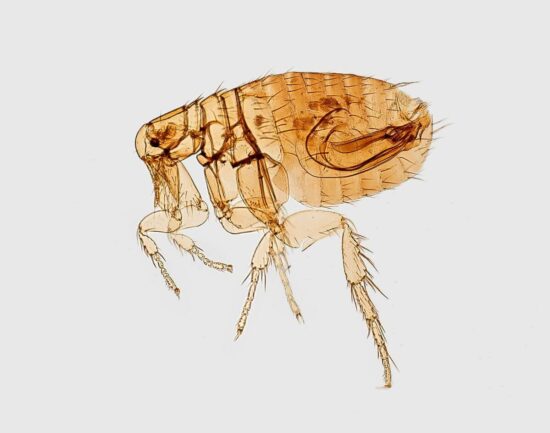Is your cat scratching like crazy? Are you seeing small red bumps on their skin? You might be dealing with flea bites on cats, one of the most common problems pet owners face. These tiny pests can make your cat miserable and turn your peaceful home into an itchy nightmare.
Flea bites on cats are more than just a minor annoyance. They can lead to serious health problems if left untreated. The good news is that with the right knowledge and approach, you can help your cat feel better and prevent future problems.
This guide will walk you through everything you need to know about flea bites on cats. You’ll learn how to spot them, treat them, and most importantly, prevent them from happening again.
How to Identify Flea Bites on Cats
Flea bites on cats appear as small red bumps or spots on the skin. They’re usually about the size of a pinhead and often show up in groups of two or three. You might notice them arranged in a line or cluster, especially around areas where your cat can’t easily scratch.
The bites often have a red ring around them and may develop small scabs in the center. Unlike mosquito bites on humans, flea bites on cats tend to stay small and don’t swell up much.
Common locations for flea bites include the base of the tail, back of the neck, behind the ears, and along the back legs. These are spots where fleas feel safe because cats have trouble reaching them to scratch or groom.
Why Fleas Bite Cats
Fleas need blood to survive and reproduce. Adult fleas can bite up to 15 times per day, taking tiny blood meals each time. Female fleas especially need blood to lay eggs, which is why infestations can grow so quickly.
Some cats are more sensitive to flea bites than others. Cats with flea allergies can have severe reactions to just one bite, while other cats might tolerate several fleas with only minor irritation. The difference comes down to how each cat’s immune system reacts to flea saliva.
Signs Your Cat Has Flea Bites
Recognizing the signs of flea bites early can help you get treatment started before the problem gets worse. Cats show their discomfort in several ways, and knowing what to look for can make all the difference.
1. Physical Signs to Look For
The most obvious sign is excessive scratching and grooming. If your normally calm cat suddenly can’t stop scratching certain areas, fleas might be the culprit. You might also notice your cat biting at their skin or licking the same spots over and over.
Red, irritated skin is another clear sign of flea problems. The skin might look inflamed or have small bumps and scabs from scratching. In severe cases, you might see hair loss and bald patches where your cat has been over-grooming.
Look for small black specks in your cat’s fur, especially around the base of the tail and neck. This “flea dirt” is actually flea poop made of digested blood. If you put these specks on a wet paper towel, they’ll turn reddish-brown.
2. Behavioral Changes
Cats with flea bites often become restless and uncomfortable. They might have trouble settling down for naps or seem generally agitated. Some cats start avoiding carpeted areas or their favorite sleeping spots if those areas have become flea-infested.
Changes in appetite or mood can also signal flea problems. The constant itching and discomfort can stress cats out, making them less interested in food or play. Some cats become more aggressive or withdrawn when dealing with persistent flea bites.
Health Problems from Flea Bites
While flea bites might seem like a minor problem, they can lead to serious health issues if not treated properly. Understanding these complications helps you know when to take action and when to seek professional help.
Immediate Effects
The most immediate problem is intense itching that can drive your cat crazy. Unlike humans who can scratch an itch and move on, cats get stuck in a cycle where scratching makes the problem worse. The more they scratch, the more irritated their skin becomes.
Skin inflammation and irritation develop quickly around bite sites. The constant scratching can break the skin, creating open wounds that are vulnerable to bacterial infections. These wounds can be painful and take time to heal.
Flea Allergy Dermatitis
Some cats develop flea allergy dermatitis, which is basically an allergic reaction to flea saliva. These cats can have severe, long-lasting reactions to just one flea bite. The allergic reaction can cause widespread itching and skin problems that extend far beyond the original bite location.
Cats with this condition often develop crusty bumps, extensive hair loss, and severely irritated skin. The reaction can last for days or even weeks after the flea is gone, making it one of the most frustrating flea-related problems for both cats and their owners.
Serious Complications
Heavy flea infestations can cause anemia, especially in kittens, elderly cats, or cats that are already sick. Fleas literally drain blood from their hosts, and if there are enough of them, this blood loss can become dangerous.
Skin infections are another serious concern. When cats scratch and bite at flea bites, they can introduce bacteria into open wounds. These infections may require antibiotic treatment and can be slow to heal.
Fleas can also transmit diseases like tapeworms and cat scratch fever. While less common than simple bite reactions, these diseases can cause additional health problems for your cat and potentially affect human family members too.
How Vets Diagnose Flea Bites on Cats
Getting a proper diagnosis is important because other problems can look similar to flea bites. Your veterinarian has the training and tools to figure out what’s really causing your cat’s skin problems.
What to Expect at the Vet
Your vet will start with a thorough physical examination of your cat’s skin and coat. They’ll look for the actual fleas, flea dirt, and signs of bite reactions. Using a fine-toothed flea comb, they can often find evidence even when fleas aren’t immediately visible.
The vet will ask about when symptoms started, where you’ve noticed problems, and whether other pets in your home are affected. This timeline helps them understand whether you’re dealing with a new infestation or an ongoing problem.
For cats with severe reactions, your vet might recommend allergy testing to confirm flea sensitivity. Blood tests can also check for anemia or other complications from heavy flea infestations.
Other Problems That Look Similar
Several other conditions can cause symptoms similar to flea bites on cats. Mites, lice, and other parasites can cause itching and skin irritation. Food allergies or environmental allergies to things like pollen or dust can also make cats scratch and develop skin problems.
Stress-related over-grooming can create bald patches and skin irritation that might look like flea damage. Some cats develop obsessive grooming habits when they’re anxious or bored, even without any parasites present.
Your vet will work through these possibilities to make sure your cat gets the right treatment for their specific problem.
Treatment Options
Once you know your cat has fleas, it’s time to take action. Effective treatment involves killing the fleas on your cat, treating your home environment, and helping your cat feel more comfortable while everything heals.
Quick Relief for Your Cat
Start with immediate comfort measures to help your cat feel better. A cool, damp cloth can soothe irritated skin, and a gentle bath with lukewarm water can remove some fleas and provide temporary relief.
Fast-acting flea treatments can start killing fleas within 30 minutes to a few hours. These are especially helpful when your cat is extremely uncomfortable and needs quick relief. Your vet can recommend the best fast-acting options for your specific situation.
Don’t forget about your home environment. Vacuum thoroughly, paying special attention to areas where your cat spends time. Wash all pet bedding, blankets, and removable fabric items in hot water.
Prescription Treatments
The most effective long-term treatments for flea bites on cats come from your veterinarian. Monthly spot-on treatments are applied to your cat’s skin and provide all-over protection for about 30 days. These treatments kill adult fleas and often prevent flea eggs from developing.
Oral flea medications work from the inside out, turning your cat’s blood into a flea-killing agent. Some cats prefer these to topical treatments, especially if they have sensitive skin or don’t like being handled for spot-on applications.
For cats that are hard to treat monthly, there are longer-lasting options that can provide protection for two to three months with a single application. Your vet will help you choose the best option based on your cat’s needs and your household situation.
Treating Severe Reactions
Cats with flea allergy dermatitis or severe skin reactions need additional medical care beyond just killing the fleas. Anti-inflammatory medications can reduce swelling, redness, and itching to help your cat feel more comfortable.
If scratching has led to open wounds or bacterial infections, antibiotics might be necessary. These help prevent serious skin infections and promote healing of damaged areas.
Some cats need ongoing management with special shampoos, skin treatments, or even allergy medications to control their reactions to flea bites.
Home and Yard Treatment
Remember that most fleas actually live in your environment, not on your cat. Treating your home is just as important as treating your pet. Use flea sprays or foggers designed for indoor use, following all label directions carefully.
Pay special attention to carpeted areas, pet bedding, and furniture where your cat likes to rest. Vacuum regularly and dispose of vacuum bags immediately, as fleas can survive inside vacuum cleaners.
If your cat goes outside or you have a yard, outdoor treatment might be necessary too. Focus on shaded, moist areas where fleas like to develop, such as under porches, in tall grass, or around outdoor pet areas.
Preventing Flea Bites on Cats
The best way to deal with flea bites is to prevent them from happening in the first place. Good prevention saves your cat from discomfort and saves you the time and expense of treating flea infestations.
Year-Round Protection
Effective flea prevention requires consistent, year-round treatment. Fleas can survive indoors even during cold weather, so seasonal treatment isn’t enough. Monthly preventive treatments are the gold standard for keeping cats flea-free.
All pets in your household need protection, even if they never go outside. Fleas can enter your home on clothing, other animals, or through open doors. If one pet has fleas, they can quickly spread to others.
Even indoor-only cats need flea prevention. It only takes one flea getting into your home to start a whole infestation, and prevention is much easier than treatment.
Types of Flea Prevention
Topical spot-on treatments are applied to your cat’s skin, usually between the shoulder blades. They spread throughout your cat’s skin and hair to provide all-over protection. Most need to be applied monthly.
Oral flea preventives come as pills or chewable treats. These work by making your cat’s blood toxic to fleas when they bite. Some cats prefer these to topical treatments, especially if they have skin sensitivities.
Modern flea collars are much more effective than old-fashioned versions. They can provide several months of protection and are convenient for cats that are difficult to pill or treat topically.
Making Your Home Flea-Proof
Regular cleaning is one of your best defenses against fleas. Vacuum frequently, especially in areas where your cat spends time. The vibration and suction remove flea eggs, larvae, and adults from carpets and furniture.
Keep humidity levels in your home below 50% if possible. Fleas need moisture to complete their life cycle, so dry air makes your home less flea-friendly. Use dehumidifiers in damp areas like basements.
Maintain your yard by keeping grass short and removing debris where fleas might develop. If you have wildlife visiting your property, they could be bringing fleas with them.
Special Situations
Some cats and households have unique needs when it comes to flea prevention and treatment. Understanding these special cases helps ensure every cat gets appropriate care.
Kittens and Flea Bites
Very young kittens need special consideration because many flea treatments aren’t safe for cats under 8 weeks old. Check age restrictions on any products you use, and ask your vet about safe options for young cats.
Kittens are at higher risk for serious complications from flea bites. They can develop life-threatening anemia much more quickly than adult cats. Watch for signs like pale gums, weakness, or unusual tiredness.
If you’re treating a nursing mother cat, make sure any products you use are safe for both mom and babies. Some treatments can be passed through milk or direct contact.
Multiple Pet Households
In homes with several pets, everyone needs treatment at the same time. Fleas will just jump from one animal to another if you only treat some of your pets. This coordinated approach prevents the back-and-forth reinfection that makes flea problems so frustrating.
Never use dog flea products on cats. Many dog treatments contain ingredients that are toxic to cats and can cause serious illness or death. Always check labels carefully and use only cat-specific products.
Plan your treatment schedule so all pets are protected simultaneously. While this might seem expensive upfront, it’s much more cost-effective than dealing with ongoing flea problems.
Indoor vs. Outdoor Cats
Outdoor cats face higher exposure to fleas and might need more robust prevention. They’re more likely to encounter other animals carrying fleas and environments where fleas thrive.
However, don’t assume indoor cats are automatically safe. Fleas can hitchhike into your home on clothing, other pets, or even through open doors. They might already be present in a new home from previous pets.
Match your prevention strategy to your cat’s lifestyle, but remember that some level of protection benefits all cats, regardless of whether they go outside.
When to Get Emergency Help
While most flea problems aren’t medical emergencies, some situations require immediate professional attention. Knowing when to seek urgent care can be crucial for your cat’s health.
Serious Warning Signs
If your cat shows signs of severe allergic reactions like difficulty breathing, extreme swelling, or collapse, get veterinary help immediately. These reactions are rare but can be life-threatening.
Watch for signs of anemia, especially in kittens or elderly cats. Pale gums, weakness, rapid breathing, or extreme lethargy can indicate dangerous blood loss from heavy flea infestations.
Open wounds from scratching that show signs of serious infection need prompt attention. Look for pus, red streaking, excessive swelling, or wounds that seem to be getting worse instead of better.
Treatment That Isn’t Working
Sometimes flea problems persist despite your best efforts. This might happen if the infestation is severe, if you’re missing part of the flea life cycle in your treatment, or if fleas in your area have developed resistance to certain products.
Cats with severe flea allergies might need specialized management that goes beyond standard flea treatment. These cats often require ongoing veterinary care to stay comfortable.
If home treatment isn’t controlling the problem after several weeks of consistent effort, it’s time to call in professional help. This might include veterinary dermatologists for your cat or pest control specialists for your home.


